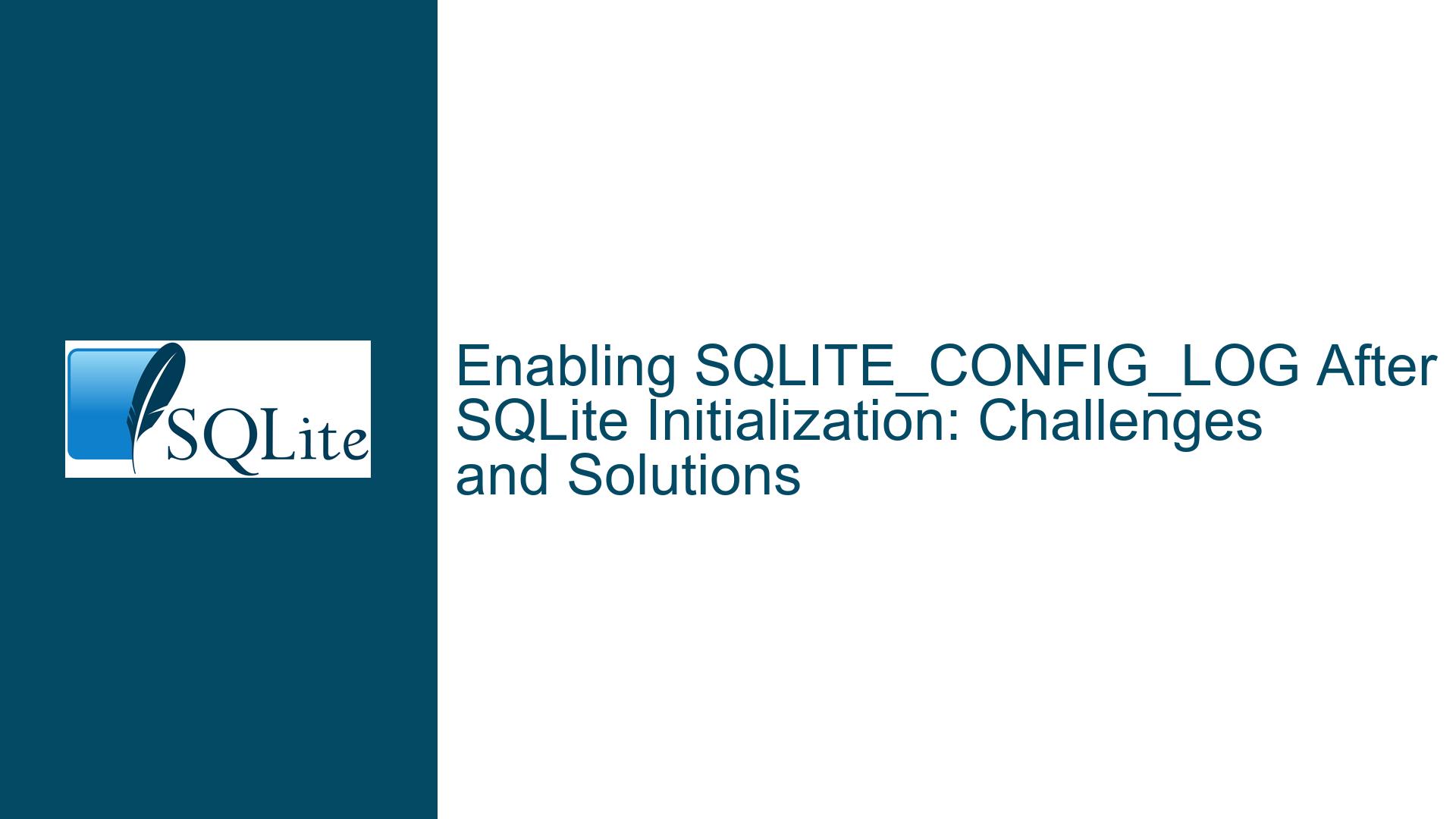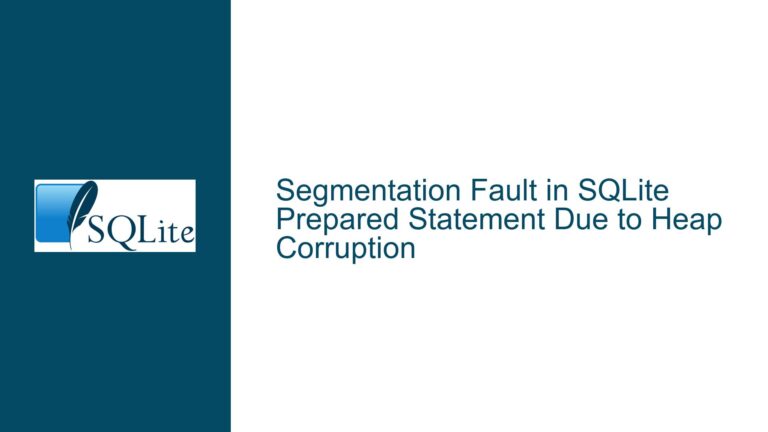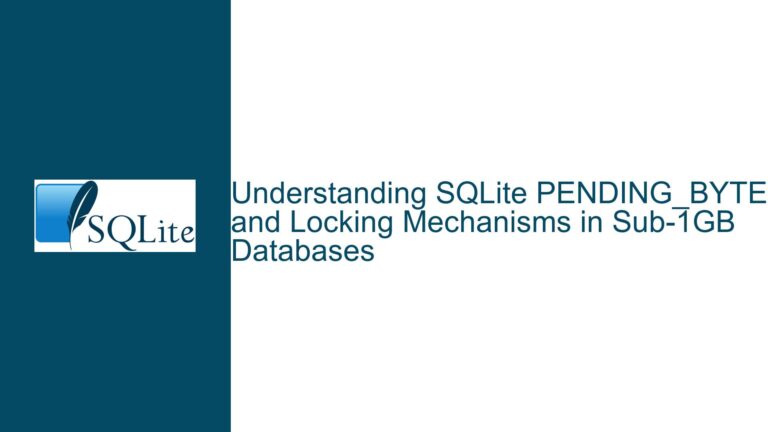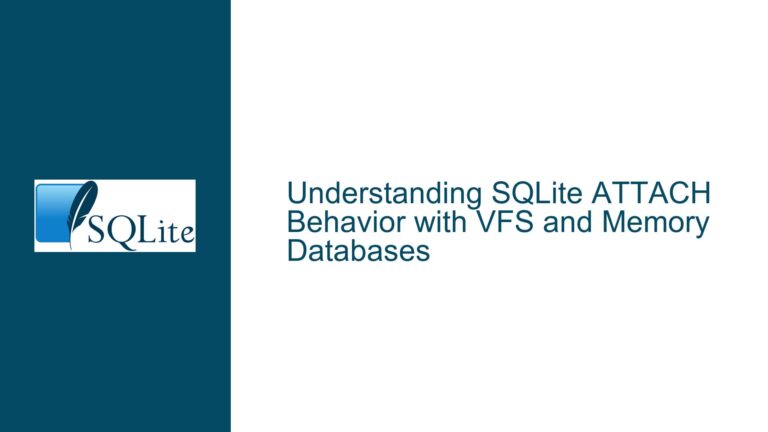Enabling SQLITE_CONFIG_LOG After SQLite Initialization: Challenges and Solutions
Understanding the Limitation of SQLITE_CONFIG_LOG Post-Initialization
SQLite is a widely-used, lightweight, and embedded relational database management system that offers a rich set of configuration options to tailor its behavior to specific application needs. One such configuration option is SQLITE_CONFIG_LOG, which allows developers to set up a custom logging function to handle SQLite’s internal logging. This logging mechanism is invaluable for debugging, monitoring, and diagnosing issues within applications that rely on SQLite.
However, a significant limitation exists with SQLITE_CONFIG_LOG: it must be configured before SQLite is initialized. This constraint can create challenges in dynamic environments where SQLite initialization might occur implicitly or earlier than expected, such as when importing third-party modules in Python or setting up SQLite in JavaScript/WASM environments. Once SQLite is initialized, any attempt to configure SQLITE_CONFIG_LOG results in an error, leaving developers without the ability to customize logging behavior at runtime.
This limitation is particularly problematic in modern application development, where modular design and dynamic loading of dependencies are common. For instance, in Python, importing a module that internally uses SQLite can trigger its initialization before the main application code has a chance to configure logging. Similarly, in JavaScript/WASM environments, the initialization sequence can make it difficult or impossible to set up logging after the fact. This issue is not limited to these environments; it has also been observed in Perl, where developers have struggled to configure logging post-initialization.
The core of the problem lies in SQLite’s design philosophy, which prioritizes simplicity and performance. Many configuration options, including SQLITE_CONFIG_LOG, are intended to be set once during the initialization phase to avoid the overhead and complexity of runtime reconfiguration. While this approach works well for many use cases, it can be restrictive in scenarios where dynamic configuration is necessary.
Exploring the Technical and Environmental Causes of the Limitation
The restriction on configuring SQLITE_CONFIG_LOG after initialization stems from several technical and environmental factors. Understanding these causes is essential to identifying potential workarounds and solutions.
1. SQLite’s Initialization Model: SQLite is designed to be lightweight and efficient, with a focus on minimal runtime overhead. To achieve this, many configuration options are locked in during the initialization phase. This design ensures that the database engine operates with predictable behavior and avoids the complexity of handling dynamic configuration changes at runtime. While this approach simplifies the internal implementation, it can be inflexible for developers who need to adapt SQLite’s behavior dynamically.
2. Thread Safety Considerations: The documentation for SQLITE_CONFIG_LOG explicitly mentions thread safety concerns. SQLite is designed to be thread-safe, but allowing runtime changes to the logging configuration could introduce race conditions or other concurrency issues. By restricting SQLITE_CONFIG_LOG to the initialization phase, SQLite ensures that the logging function is set up in a controlled environment, minimizing the risk of threading problems.
3. Implicit Initialization in Modular Environments: In modern programming environments, SQLite initialization can occur implicitly when modules or libraries that depend on SQLite are imported or loaded. For example, in Python, importing a module that uses SQLite can trigger its initialization before the main application code runs. This behavior makes it difficult to configure logging before initialization occurs, especially in large or complex codebases where dependencies are not always under the developer’s control.
4. Language-Specific Challenges: Different programming languages and environments have unique characteristics that can exacerbate the issue. In Python, the dynamic nature of module imports can lead to unexpected initialization sequences. In JavaScript/WASM environments, the asynchronous and event-driven nature of the runtime can complicate the setup process. In Perl, the lack of a straightforward mechanism to intercept SQLite initialization adds to the difficulty. These language-specific challenges highlight the need for a more flexible approach to configuring SQLITE_CONFIG_LOG.
5. Lack of Runtime Reconfiguration Support: SQLite’s architecture does not currently support runtime reconfiguration of many options, including SQLITE_CONFIG_LOG. This limitation is rooted in the desire to keep the codebase simple and maintainable. However, as SQLite is increasingly used in dynamic and modular environments, this design choice can become a hindrance.
Strategies for Enabling Custom Logging Post-Initialization
While the current limitations of SQLITE_CONFIG_LOG present challenges, there are several strategies that developers can employ to achieve custom logging in environments where SQLite initialization occurs early or implicitly. These strategies range from workarounds within the existing constraints to proposals for enhancing SQLite’s functionality.
1. Pre-Initialization Configuration: The most straightforward approach is to ensure that SQLITE_CONFIG_LOG is configured before SQLite is initialized. This can be achieved by explicitly setting up the logging function at the start of the application, before any modules or libraries that use SQLite are imported. In Python, for example, this might involve placing the configuration code in a dedicated initialization script that runs before the rest of the application. While this approach works in some cases, it may not be feasible in all scenarios, particularly in large or modular codebases where dependencies are not easily controlled.
2. Wrapping SQLite Initialization: Another strategy is to wrap SQLite initialization in a custom function or class that ensures SQLITE_CONFIG_LOG is configured before any database operations occur. This approach requires careful management of the initialization sequence and may involve modifying third-party libraries to delay their use of SQLite until after logging is set up. While effective, this method can be complex and may introduce additional maintenance overhead.
3. Using a Proxy Logging Function: In environments where SQLITE_CONFIG_LOG cannot be configured post-initialization, developers can use a proxy logging function that redirects SQLite’s internal logs to a custom handler. This approach involves intercepting the log messages at a higher level, such as by overriding the default logging mechanism or using a middleware layer. While this method does not directly address the limitation of SQLITE_CONFIG_LOG, it provides a way to achieve custom logging behavior without modifying SQLite’s internal configuration.
4. Proposing Enhancements to SQLite: For long-term solutions, developers can propose enhancements to SQLite that allow SQLITE_CONFIG_LOG to be configured after initialization. This could involve adding a new API function or modifying the existing implementation to support runtime reconfiguration. Such changes would need to carefully address thread safety concerns and ensure that the modifications do not introduce significant overhead or complexity. Engaging with the SQLite community and contributing to the development process can help drive these enhancements forward.
5. Leveraging Language-Specific Features: Some programming languages offer features that can be used to work around the limitations of SQLITE_CONFIG_LOG. For example, in Python, developers can use the atexit module to register a function that configures logging before the application exits. While this does not provide real-time logging, it can be useful for capturing logs during shutdown. Similarly, in JavaScript/WASM environments, developers can use event listeners or hooks to intercept SQLite initialization and configure logging dynamically.
6. Custom Builds of SQLite: In cases where none of the above strategies are feasible, developers can consider creating a custom build of SQLite that supports runtime configuration of SQLITE_CONFIG_LOG. This approach involves modifying the SQLite source code to remove the initialization restriction and recompiling the library. While this provides the most flexibility, it also requires significant effort and may not be practical for all projects.
7. Community Collaboration and Best Practices: Finally, developers can collaborate with the broader SQLite community to share best practices and workarounds for configuring SQLITE_CONFIG_LOG in challenging environments. By documenting successful strategies and contributing to open-source projects, developers can help others facing similar issues and drive improvements in SQLite’s functionality.
In conclusion, while the current limitations of SQLITE_CONFIG_LOG present challenges, there are multiple strategies that developers can employ to achieve custom logging in dynamic and modular environments. By understanding the technical and environmental causes of the limitation and exploring creative solutions, developers can overcome these challenges and leverage SQLite’s powerful logging capabilities to their fullest extent.






